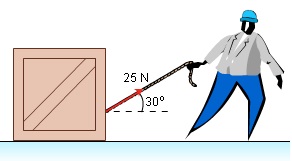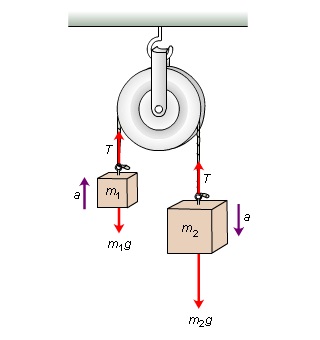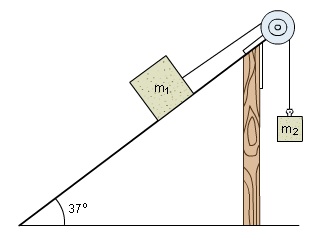Assignment:
Question 1: A 1.5-kg object moves up the y-axis at a constant speed. When it reaches the origin, the forces F1 = 5.0 N at 37o above the +x-axis, F2 = 2.5 N in the +x-direction, F3 = 3.5 N at 45o below the -x-axis, and F4 = 1.5 N in the -y-direction are applied to it. (a) Will the object continue to move along the y-axis? (b) If not, what simultaneously applied force will keep it moving along the y-axis at a constant speed?
Question 2: In a college homecoming competition, 16 students lift a sports car. While holding the car off the ground, each student exerts an upward force of 400 N. (a) What is the mass of the car in kilograms? (b) What is the weight in pounds?
Question 3 A boy pulls a box of mass 30 kg with a force of 25 N in the direction shown in the figure.

(a) Ignoring friction of the box, what is the acceleration of the box?
(b) What is the normal force exerted on the box by the ground?
Question 4 The Atwood machine consists of two masses suspended from a fixed pulley. It is named after British scientist George Atwood (1746 - 1807), who used it to study motion and to measure the value of g. if m1 = 0.55kg and m2 = 0.80 kg, (a) what is the acceleration of the system, and (b) what is the magnitude of the tension in the string?

Question 5: In the ideal apparatus shown in the diagram, m1 = 2.0 kg. What is m2 if both masses are at rest? How about if both masses are moving at constant velocity?

Question 6: A particle moves as at speed of 2.5 m/s in the +x-direction. Upon reaching the origin, the particle receives a continuous constant acceleration of 0.75 m/s2 in the -y-direction. What is the position of the particle 4.0 s later?
Question 7 Given two vectors A, which has a length of 10.0 and makes an angle of 45o below the -x-axis, and B, which has an x-component of +2.0 and y-component of +4.0, (a) sketch the vectors on x-y axes, with all their "tails" starting at the origin, and (b) calculate A + B.
Question 8: A roller coaster at an amusement park starts out on a level track 50.0 m long and then goes up a 25.0-m incline at an angle of 30o to the horizontal. It then goes down a 15.0-m ramp with an incline of 40o to the horizontal. When the roller coaster has reached the bottom of the ramp, what is its displacement from the starting point?
Question 9: While you are traveling in a car on a straight, level inter-state highway at 90 km/h, another car passes you in the same direction; its speedometer reads 120 km/h. (a) What is your velocity relative to the other driver? (b) What is the other car's velocity relative to you?
Question 10 A boat that travels at the speed of 6.75 m/s in still water is to go directly across a river and back. The current flows at 0.50 m/s. (a) At what angle(s) must the boat be steered?
Question 11 A 2.05 m tall basketball player takes a shot when he is 6.02 m from the basket (at the three-point line). If the launch angle is 25o and the ball was launched at the level of the player's head, what must be the release speed of the ball for the player to make the shot? The basket is 3.05 m above the floor.